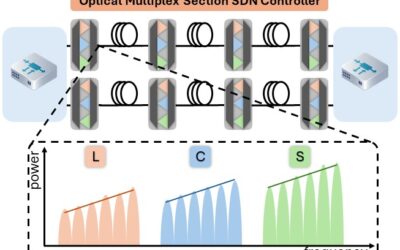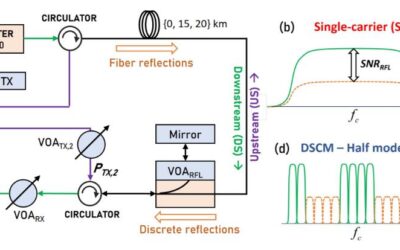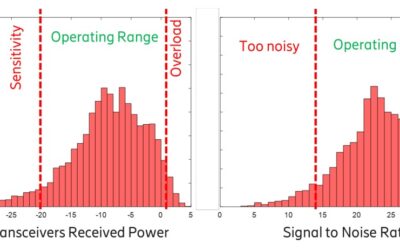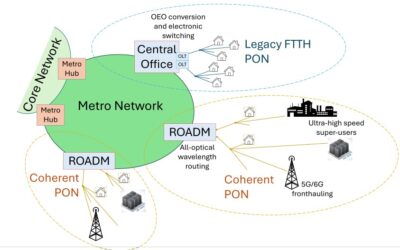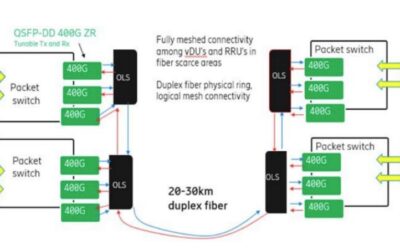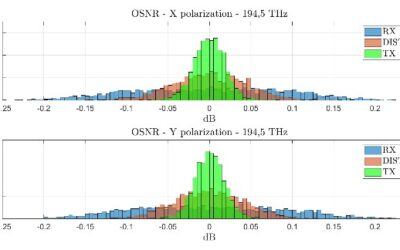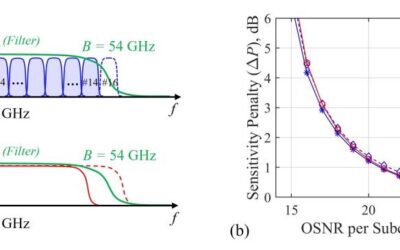About ALLEGRO ‘Agile ultra low energy secure networks’
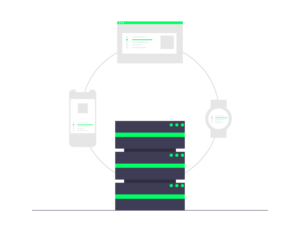 ALLEGRO aims at designing and validating a novel end-to-end sliceable, reliable, and secure architecture for next-generation optical networks, achieving high transmission/switching capacity
ALLEGRO aims at designing and validating a novel end-to-end sliceable, reliable, and secure architecture for next-generation optical networks, achieving high transmission/switching capacity
- with 10 Tb/s for optoelectronic devices and 1 Pbt/s for optical fiber systems
- low power consumption/cost
- with > 25% savings
- and secure infrastructures and data transfers.
The architecture relies on key enabling innovations:
- smart, coherent transceivers exploiting multi-band & multi-fiber technologies for P2P and P2MP applications, based on e.g., high-speed plasmonic modulators/photodetectors and programmable silicon photonic integrated waveguide meshes;
- loss-less, energy-efficient transparent photonic integrated optical switches, eliminating OEO conversions, e.g., with on-chip amplification in the O-band for datacom applications;
- a consistent approach to security, in terms of functional/ protocol architectures and communications, further improving QKD systems, enabling optical channel co-existence and researching on quantum-resistant (post-quantum) cryptography, developing systems based on physically unclonable functions; and
- a scalable AI/ML assisted control and orchestration system, responsible for autonomous networking, dynamic and constrained service provisioning, function placement and resource allocation, leveraging devices increasing programmability and overall network softwarization.
To achieve the target objectives and KPIs, ALLEGRO has defined a clear methodology ending in ambitious demonstrators. The consortium includes a good balance of industry and research/academia with know-how in complementary fields.
The results of ALLEGRO will be disseminated in leading conferences, events, and high-impact journals. They will have a concrete and measurable economic and social impact, contributing towards achieving key European objectives, reinforcing European leadership and digital sovereignty in the ongoing digital and green transition.
Project News
Exploring Power Optimization and GSNR Estimation in Multi-Band Optical Systems
As optical networks evolve beyond the traditional C-band, power optimization becomes increasingly complex. The LOGO approach has been a reliable method for determining optimal signal launch power within the C-band. However, as we expand into multi-band transmission,...
Launch of Power Optimization in Single-Fibre, Single-Wavelength Coherent P2P Transport Networks
As mobile transport networks evolve, the need for high-capacity, single-fibre bidirectional (Bi-Di) transmission links becomes increasingly critical to maintain strict timing and synchronization requirements. In the ALLEGRO project, we are pushing the boundaries of...
Optimizing Amplifier Gain Strategy for RAN in DWDM Networks
Managing EDFA amplifiers in a DWDM network is a complex challenge. The choice between constant gain mode and constant power mode directly impacts power stability, OSNR, and overall network performance. 🔹 Key Considerations: ✅ Constant Power Mode – Preferred in highly...
Enhancing ROADMs with a Modified Broadcast-and-Select Architecture
Traditional ROADMs and WSSs face limitations in efficiently supporting Point-to-Multipoint (P2MP) optical networks. To overcome these challenges, we propose a modified Broadcast-and-Select (B&S) ROADM architecture that improves spectrum efficiency and minimizes...
Long-Access Metro + PON Convergence: Unlocking the Span Budget
PON has become the gold standard for fixed optical access, with over a billion terminations deployed globally. As ITU-T and IEEE drive new standards to push bit rates even further, the discussion now includes 200 Gb/s per wavelength using PM-QAM and coherent...
Amplified Access Ring with Filter-less Add/Drop Operation
In the ALLEGRO project, we've explored how pluggable EDFAs—low-cost amplifiers primarily designed for DCI applications—can be leveraged in multi-span DWDM networks despite their limitations. 🔍 Challenges with Pluggable EDFAs:✔️ Lack of variable gain operation with...
Monitoring Natural Disasters with Optical Fibres
Can optical fibres double as seismic sensors? Yes! Our work within the ALLEGRO project explores how state of polarization (SOP) variations in fibre-optic networks can be leveraged for earthquake detection and early warning systems. 📡🌎 🔬 How it Works:Using commercially...
Low-complexity Failure Management in Optical Networks
In the ALLEGRO project, we’ve taken a step forward in ML-driven failure management by developing a NN-based soft failure identifier that maintains high accuracy while significantly reducing complexity. 🔍💡 📌 Why is this important?Most ML-based failure detection models...
Polarization Dependent Loss in Metropolitan Optical Networks
With the ever-growing demand for Internet traffic, driven by 5G, cloud services, and online applications, metropolitan optical networks are evolving to meet these increasing capacity needs. However, as networks rely more on coherent optical technologies and...
System-Level Model Application in ALLEGRO
As part of our ongoing work in the ALLEGRO project we've been leveraging system-level modeling to analyze and compare the performance of Single Carrier (SC) and Discrete Spectrum Carrier Multiplexing (DSCM) systems under narrow filtering constraints. 🔎 Key Insights:✅...
